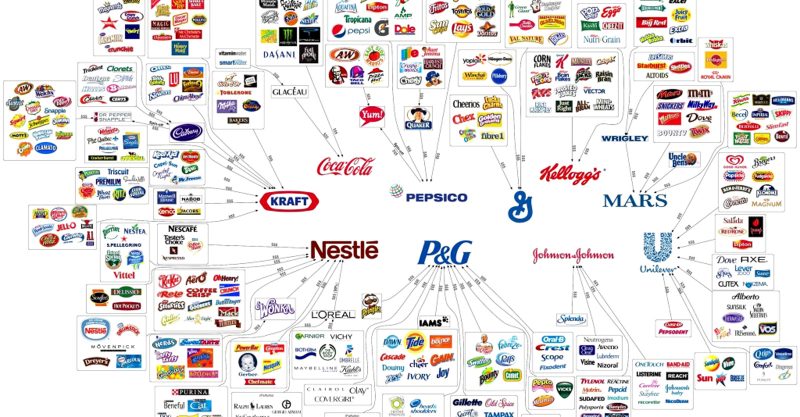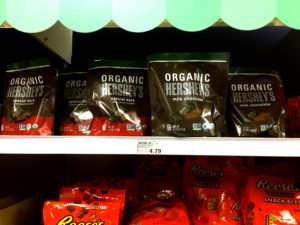Last night my 12 and 14-year old children informed me that although they no longer believe in the Easter Bunny, they still believe in the Easter Mommy and were fully expecting Easter baskets overflowing with sugary candy which are usually filled with chemicals and unfood ingredients. Knowing that the remaining years where they will be enthusiastically game for a full-on Easter egg hunt are few, I foraged to the local grocery story at 11pm to see if I could source any kind of tasty treats that I would find, at least, partially acceptable for human consumption.
Most junk food, and even products marketing themselves as “natural” and “organic” are normally just overprocessed unfoods that have dressed up their ingredient lists with some things that are not quite as deplorable as high fructose corn syrup, red dye #40, and a laundry list of preservatives, emulsifiers, and coloring agents designed to address the aesthetics of food and engineered to intentionally create addictions to sugar even in foods that are not sweet just for the sake of marketing. Ordinarily, I would have ventured to a health food market with a much better variety of healthier candy choices, but with an hour to spare before the clock struck Easter, my options were limited.
I am used to dissecting food labels and my shopping trips are notorious for being lengthy if I am sourcing something that is not a staple on my usual list, so I expected this trip, in particular, might pose a challenge. What I found, however, is that there has been a notable shift towards healthier ingredients in the last few years that is being driven by consumer demand. There are a number of healthier candy brands that have emerged and are making their way onto even conventional supermarket shelves, but what I discovered in my twilight expedition to the local Meijer store was that even Big Food manufacturers are beginning to respond to consumer demands for healthier options.
I am, by no means, a proponent of Big Food makers like Mars, Kraft, Proctor and Gamble, Kellogg’s, Nestle, CocaCola, Johnson and Johnson, and the like. As George Orwell predicted in his dystopian writings, absolute power does, in fact, corrupt absolutely. The number of food brands that are controlled by a select few parent companies should cause alarm for the future of our food supply, and I will always support smaller companies that are passionate about the roots of their healthy ingredients as a means to promote health, vitality, and longevity amongst their patrons. As we learned with telecom and other industries in the last century, monopolies are not good for humanity at large. Once an organization exceeds a certain size, it essentially turns into a machine that is disconnected from serving the people of which it may have originally started out to enhance the lives. There is an inherent disconnect, however, when an organization grows beyond its ability to operate at a level that recognizes individuals. Profit, in and of itself is not the problem. Profit and perpetual growth of profit as the end goal rather than providing a product or service designed to improve people’s lives and experiences ultimately ends up being the purpose of corporate entities that have grown beyond the capacity to be of service to its consumers rather than its shareholders.

Here’s the silver lining, however. While I was shopping, I discovered a bag of Organic Hershey chocolate bars. I was skeptical. I assumed the ingredient list would be filled with the same emulsifiers and chemical agents found in other conventional Standard American Diet (SAD) candy brands. But here is what I found….
Ingredient list for Organic Hershey’s Special Dark Chocolate: Organic Chocolate, Organic Sugar, Organic Cocoa Butter, Organic Vanilla Extract, and Organic Milk.
While there is some additional information that might be offered about the type of chocolate being used and the origins of the sugar and milk, by contrast to most candy brands, this list is not terrible. I almost never eat any form of processed sugar and opt for homemade treats where I can control the ingredients and opt for local raw honey, dates, monk fruit, or stevia to sweeten our recipes. My reason for noting the Hershey’s Organic option here is simply that the corporation is responding to market demands. We have reached a tipping point where enough consumers have done their own independent research and are no long willing to settle for subpar ingredients that contribute to chronic inflammation and toxic overload in the body. Eating Hershey bars of any variety is not going to pave the way to health, but, perhaps, the fact that so many Big Food manufacturers are now offering gluten free, grain free, organic, chemical free, emulsifier free, artificial color free, simpler ingredient lists, even if their motivation is purely profit-driven, is a sign that consumers at large are driving market demand for integrity in food manufacturing.
“Food manufacturing” really should not even be part of our culinary vocabulary as real food is grown, not manufactured, however, such is the world in which we live, and the pendulum at least seems to be returning to a direction of health and integrity even if the steps to get there are small. Most of my Easter candy purchases were with smaller brands that have found natural and safe alternatives to processed sugar and do not have direct ties to Monsanto, which is another conversation entirely, but I am encouraged that Big Food is responding to consumers’ investment in products that align with health.
Reading food labels is not rocket science, by any stretch of the imagination. Certainly it is a practiced skill, but once you learn how to do it, making decisions between virtually identical items, one that can be considered real food and another that is highly processed unfood becomes second nature that does not require one simply go without. Making better choices is, well, a choice. Society can continue to settle for complacency and the chronic diseases that accompany it, or we can be proactive, respect our personal autonomy and health freedom, and continue to shape the future of real food versus unfood by investing our dollars in real food that nourishes rather than chemical laden unfoods that tip the balance from health to disease.
There is only one state of disease in the human body, imbalance. Creating that balance is really quite simple. Make a commitment to yourself and your family to consume only real food. Eating healthy does not require deprivation, elimination, or fad-style food combinations. Start with eating real food and health will follow.
Happy Easter from the Easter Mommy!


